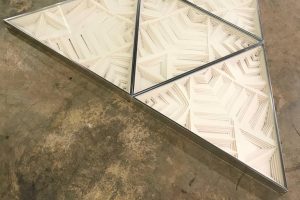From Flat to Fabulous: The Magic of Dimensional Wall Art

Exploring the Impact of Dimensional Wall Art
Dimensional wall art, with its captivating textures and layers, has the remarkable ability to transform a dull wall into a vibrant canvas of expression. It invites viewers to engage more intimately with art, encouraging them to explore and appreciate the craftsmanship involved.
- From Flat to Fabulous: The Magic of Dimensional Wall Art
- Exploring the Impact of Dimensional Wall Art
- History of Dimensional Wall Art
- Types of Dimensional Wall Art
- Sculptural Wall Hangings
- Mosaic Wall Art
- Materials and Tools for Creating Dimensional Wall Art
- Wood, Metal, and Fabric
- Paints, Glues, and Brushes
- Techniques for Making Dimensional Wall Art
- Relief Sculpting
- Mixed Media Collage
- Choosing the Perfect Location for Dimensional Wall Art
- Living Room Statement Pieces
- Bedroom Accent Walls
- DIY vs. Purchasing Dimensional Wall Art
- Cost-Effective DIY Options
- Investing in Professional Pieces
- Maintaining and Cleaning Dimensional Wall Art
- Dusting and Wiping Techniques
- Repairing Damaged Pieces
- Inspirational Ideas for Dimensional Wall Art
- Nature-Inspired Designs
- Geometric Patterns and Abstract Art
- Contemporary Trends in Dimensional Wall Art
- Sustainable and Recycled Materials
- Interactive and 3D Printed Art
- Conclusion
- Embracing Creativity
- Creates Depth: Unlike traditional flat art, dimensional wall art adds physical depth, allowing viewers to experience different perspectives.
- Enhances Ambiance: This form of art can evoke emotions and set moods, making it a powerful tool in interior design.
History of Dimensional Wall Art
The roots of dimensional wall art can be traced back to ancient cultures that used relief sculptures to tell stories. For instance:
- Ancient Egypt: Hieroglyphics and carvings adorned tombs and temples.
- Renaissance Era: Artists like Michelangelo revolutionized dimensions in art, integrating perspectives that drew viewers into their creations.
Over time, the techniques and materials have evolved, leading to modern interpretations that blend traditional craftsmanship with contemporary styles. This evolution continues to inspire artists and enthusiasts alike, opening new avenues for creativity and expression.
Types of Dimensional Wall Art
Sculptural Wall Hangings
Sculptural wall hangings provide an extraordinary way to introduce three-dimensional elements into any space. These pieces often combine various materials—like metal, wood, and glass—to create unique designs that elevate the aesthetic of a room. For example, a stunning metal tree sculpture can serve as a focal point in a living room, inviting compliments and intrigue from visitors.
- Versatility: Sculptural wall hangings can fit any theme, from rustic to modern, allowing for personal expression.
- Dynamic Effects: The play of light and shadows on three-dimensional surfaces can change the feel of a room throughout the day.
Mosaic Wall Art
Mosaic wall art combines small pieces of material—such as glass, stone, or tile—to create intricate designs that burst with color. This art form is not only visually captivating, but it’s also historically rich, with roots in ancient civilizations.
- Customizable: Mosaics can be tailored to suit any design, making them perfect for personalized projects.
- Textural Richness: The varied materials give depth and texture, making each piece a tactile experience.
Whether opting for the bold presence of sculptural designs or the intricate beauty of mosaics, both types of dimensional wall art offer unique opportunities to enhance home decor.
Materials and Tools for Creating Dimensional Wall Art
Wood, Metal, and Fabric
When it comes to creating dimensional wall art, the choice of materials can drastically affect the final outcome. Wood, metal, and fabric each offer unique properties and aesthetics that can inspire limitless creativity.
- Wood: This classic material is not only sturdy but also versatile. Carving or layering wooden pieces can create stunning effects. For example, salvaged wood can add rustic charm to a piece.
- Metal: Often used for sculptural designs, metal adds an industrial edge. Think of intricate metal cutouts that play with light and shadow—just breathtaking!
- Fabric: Utilizing fabrics (like felt or canvas) allows for softness and texture. Creating layered fabric art can bring a cozy, inviting feel to any room.
Paints, Glues, and Brushes
No masterpiece is complete without the right tools. Quality paints, glues, and brushes play crucial roles in the finishing touches of dimensional wall art.
- Paints: From acrylics to spray paints, they enable artists to add color and depth. Vibrant hues can bring life to wood, while metallic paints can enhance metal pieces.
- Glues: Strong adhesives are necessary for attaching different materials. A hot glue gun is a favorite for quick, secure bonds.
- Brushes and Applicators: Brushes come in various shapes and sizes to allow for fine details or broader strokes. For those intricate parts, a fine-tipped brush can work wonders.
Choosing the right combination of materials and tools not only sets the foundation for creativity but also determines the longevity of the art piece. As the saying goes, a craftsman is only as good as their tools!
Techniques for Making Dimensional Wall Art
Relief Sculpting
Relief sculpting is an enchanting technique that adds depth and texture to wall art. This approach involves carving or modeling designs that project from a flat surface, creating a visually striking effect.
- Layering: Artists often use multiple layers of material to enhance the three-dimensional aspect.
- Tools: Basic tools like carving knives, chisels, and molds can be used to manipulate the material. For instance, I remember using clay to create relief sculptures in art classes, where each carving revealed spectacular depth and detail.
The magic happens when light interacts with the raised elements, casting shadows that bring the art to life.
Mixed Media Collage
Mixed media collage is another exciting technique that combines various materials to create a cohesive piece of art. By merging paper, fabric, paint, and found objects, artists can express a diverse range of emotions and stories.
- Personalization: This technique allows for immense creativity, as artists can incorporate personal items like tickets or photographs to tell their story.
- Texture and Color: Using different materials elevates the visual interest. For instance, I once created a piece using fabric scraps and old book pages, resulting in a tactile masterpiece that was both nostalgic and vibrant.
Both relief sculpting and mixed media collage provide unique avenues for artists to explore their creativity and communicate their vision. Each technique speaks to the heart of dimensional wall art, inviting viewers on a journey of discovery.
Choosing the Perfect Location for Dimensional Wall Art
Living Room Statement Pieces
Selecting the right location for dimensional wall art can dramatically enhance its impact, especially in the living room where first impressions matter. A statement piece, like a large sculptural wall hanging, can serve as the focal point of the room.
- Wall Space: Choose a prominent wall that lacks decor to let your art shine.
- Eye-Level Placement: Hang pieces at eye level to create an engaging experience for viewers.
- Complementing Decor: Coordinate the colors and materials with existing furniture for a cohesive look. There’s something magical about seeing a vibrant piece of art breathe life into a previously bare wall, as I experienced when I added a bold metal sculpture above my sofa.
Bedroom Accent Walls
In the bedroom, dimensional wall art can create an atmosphere of tranquility and intimacy. An accent wall adorned with textured pieces can enhance the overall aesthetic while evoking a sense of calm.
- Mood-Setting: Choose harmonious colors and soft textures that promote relaxation.
- Personal Touch: Incorporate artwork that reflects personal interests or memories, such as a fabric collage made from keepsakes. This personal touch transformed my bedroom into a sanctuary—each piece telling a story that brings warmth to the space.
A well-placed piece of dimensional wall art can truly elevate the feel of a room, making it not only a decor choice but also a significant part of your home’s narrative.
DIY vs. Purchasing Dimensional Wall Art
Cost-Effective DIY Options
When it comes to dimensional wall art, the DIY route is not only budget-friendly but also a chance to unleash creativity. Crafting your own pieces allows for personalization that store-bought items can’t replicate.
- Materials: Many DIY projects can be created with inexpensive materials like cardboard, wood scraps, or even recycled items.
- Time and Enjoyment: The process can be incredibly rewarding. I recall creating a vibrant fabric wall hanging from leftover fabric, and every time I see it, I remember the joy of creating it.
Furthermore, there are numerous online tutorials that guide artists of all skill levels, making it easier than ever to start a meaningful project.
Investing in Professional Pieces
On the other hand, investing in professional dimensional wall art can yield stunning results and support local artists.
- Quality and Durability: Professionally crafted pieces often feature superior materials and techniques that can last a lifetime.
- Expert Design: These artworks are typically designed to make a significant statement and can be tailored to match various decor styles. For example, I once splurged on a stunning metal wall sculpture that instantly became the centerpiece of my living room—an investment that definitely paid off in terms of beauty and conversation starter!
Whether opting for DIY or purchasing from artists, both avenues offer unique benefits. Ultimately, it comes down to personal preference, style, and budget, allowing art lovers to choose what fits their home best.
Maintaining and Cleaning Dimensional Wall Art
Dusting and Wiping Techniques
Maintaining dimensional wall art not only preserves its beauty but also prolongs its lifespan. Regular cleaning should be part of your routine to keep your pieces looking fresh.
- Gentle Dusting: Use a soft feather duster or a microfiber cloth to gently remove dust. This prevents particles from scratching the surface. I always keep a cloth handy for a quick dusting every now and then, especially for my intricate fabric art pieces that easily accumulate dust!
- Wiping: For more thorough cleaning, lightly dampen a cloth with water or a gentle cleaner and wipe down the surface. Avoid using harsh chemicals, which can damage materials.
Repairing Damaged Pieces
Even the most cared-for art can suffer from time to time. Luckily, many minor damages can be easily repaired.
- Assessing Damage: First, evaluate the extent of the damage. Small scratches on wood can often be masked with wood polish or a stain marker.
- Reattaching Parts: If a piece has become detached, a strong adhesive or hot glue can work wonders. I once had a metal piece lose its attachment point, and a quick re-glue restored its charm.
Taking the time to maintain and repair dimensional wall art ensures it remains a cherished focal point in your home for years to come. Remember, art is an investment, and a little care can go a long way!
Inspirational Ideas for Dimensional Wall Art
Nature-Inspired Designs
Nature’s beauty is a boundless source of inspiration for dimensional wall art. Incorporating elements from the great outdoors can create a serene and calming atmosphere in any space.
- Wooden Tree Sculptures: These can showcase intricate bark textures and flowing branches, bringing a piece of nature indoors. I recently crafted a layered wood art piece resembling a tree canopy, and it has become a favorite in my living room.
- Floral Reliefs: Consider designing a wall hanging with 3D flowers fashioned from fabric or paper. This not only adds color but also texture, creating a vibrant focal point.
Geometric Patterns and Abstract Art
On the flip side, geometric patterns and abstract art excite a modern aesthetic and invite creative interpretations.
- Layered Shapes: Create an art piece using overlapping geometric shapes, such as triangles or circles, made from different materials like metal and wood. This combination creates a captivating visual dynamism.
- Mixed Media Abstracts: Combining various elements such as paint, paper, and fabric can tell a more profound narrative, exploring colors and textures in a freeform manner.
Whenever I see geometric art in a space, it adds an element of sophistication and intrigue that captures the eye. Whether you lean toward nature motifs or modern abstract designs, the possibilities for dimensional wall art are truly endless!
Contemporary Trends in Dimensional Wall Art
Sustainable and Recycled Materials
In recent years, the movement toward sustainability has significantly influenced the world of dimensional wall art. Artists are increasingly turning to recycled materials, breathing new life into things that would otherwise be discarded.
- Creative Upcycling: Old wood, metal scraps, and even discarded plastic can be repurposed into stunning pieces. I recently came across a beautiful wall piece made from old bicycle parts, creatively transformed into a floral design.
- Eco-Friendly Choices: Using sustainable materials not only minimizes waste but also supports eco-conscious practices in the art community.
This trend resonates deeply with art enthusiasts who value both aesthetics and environmental responsibility.
Interactive and 3D Printed Art
Another exciting trend is the incorporation of technology into dimensional wall art. Interactive art engages viewers in new and delightful ways.
- Interactive Elements: Some artists create pieces that viewers can touch or move, inviting an immersive experience. For example, a wall-mounted puzzle art allows observers to rearrange pieces, making it a constantly evolving work.
- 3D Printing: The advent of 3D printing technology has opened up new possibilities for artists. Intricate designs that were once challenging to create by hand can now be printed, enabling more complex structures and patterns.
These contemporary trends in dimensional wall art reflect a fusion of creativity, technology, and sustainability, showcasing how art continues to evolve and inspire in the modern age.
Conclusion
In exploring the fascinating world of dimensional wall art, we’ve discovered the immense variety and creative possibilities that this art form offers. From the historical roots and evolving techniques to contemporary trends, the journey of dimensional wall art is both rich and inspiring.
Embracing Creativity
Whether choosing to create your own pieces or invest in the work of skilled artists, there’s something truly magical about dimensional art.
- Personal Connection: Crafting your own designs fosters a personal connection to your space, while purchasing professional pieces can elevate your décor with emotional and artistic significance.
- Individual Expression: The versatility of materials and techniques allows everyone to express their unique style.
You don’t have to be an experienced artist to appreciate or create dimensional wall art. With an open mind and a willingness to explore, anyone can find joy in bringing three-dimensional life to their walls. So go ahead, embrace your creativity, and let your walls tell a story!





